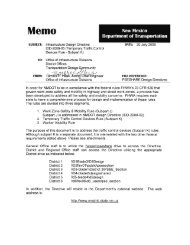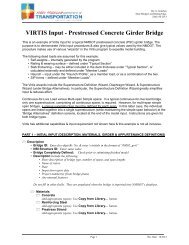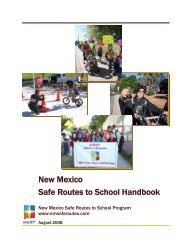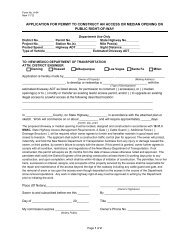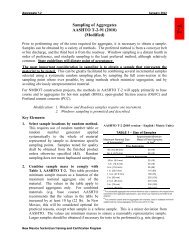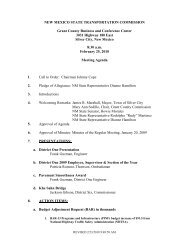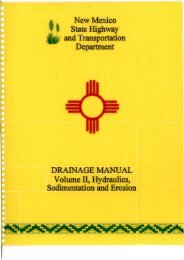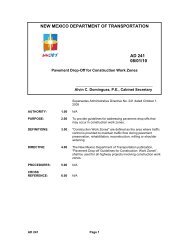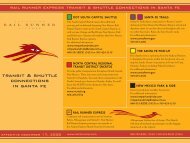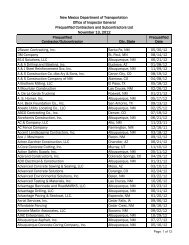NM 532 Curve Correction Project - New Mexico Department of ...
NM 532 Curve Correction Project - New Mexico Department of ...
NM 532 Curve Correction Project - New Mexico Department of ...
Create successful ePaper yourself
Turn your PDF publications into a flip-book with our unique Google optimized e-Paper software.
<strong>NM</strong> <strong>532</strong> <strong>Curve</strong> <strong>Correction</strong> <strong>Project</strong> Environmental Assessment<br />
4.6 Vegetation<br />
Existing Conditions –The major vegetation types are montane coniferous forest, subalpine coniferous<br />
forest, and montane grassland. Montane coniferous woodland has a tree canopy with dominant species<br />
consisting <strong>of</strong> ponderosa pine, Douglas fir, and white fir. Subalpine coniferous forest occurs at higher<br />
elevations than the montane coniferous woodland and has a tree canopy with dominant species consisting<br />
<strong>of</strong> corkbark fir and Engelmann Spruce. Montane grassland grows in open areas without a tree canopy<br />
and is dominated by grasses such as Thurber fescue, Arizona fescue, and Kentucky bluegrass. Large<br />
areas <strong>of</strong> gambel oak thickets are also present in the project area. Portions <strong>of</strong> the project area were burned<br />
in the 2012 Little Bear Fire (see Figures 2.1, 4.1, and 4.2).<br />
Potential Effects and Mitigation Measures – Vegetation disturbance would occur at cut and fill areas<br />
and other roadside areas. Approximately 6 acres <strong>of</strong> vegetation would be affected.<br />
4.7 Fish and Wildlife<br />
Existing Conditions – High quality wildlife habitat occurs along the <strong>NM</strong> <strong>532</strong> <strong>Project</strong> Area. The mixture<br />
<strong>of</strong> forest cover, open grasslands, and riparian areas with good water sources results in relatively high<br />
wildlife populations. Both elk and mule deer have large populations and are easily observed. Black bear,<br />
coyote, striped skunk, and a wide variety <strong>of</strong> small mammals are present. The mixture <strong>of</strong> forested and<br />
open areas with easily accessible water sources provide good bird habitat. Important fish habitat occurs<br />
downstream <strong>of</strong> the project area in the North Fork <strong>of</strong> the Rio Ruidoso, Eagle Creek, and Eagle Lakes.<br />
Potential Effects and Mitigation Measures – Wildlife habitat disturbance would occur at cut and fill<br />
areas in the <strong>NM</strong> <strong>532</strong> <strong>Project</strong> Area, affecting approximately 6 acres. Any tree cutting or shrub clearing<br />
would occur outside <strong>of</strong> the migratory bird nesting season (March 1 through August 30), or a nesting<br />
survey would be completed prior to tree cutting. Wildlife would be temporarily disturbed during<br />
construction. BMPs would be needed to ensure protection <strong>of</strong> fish habitat water quality during and after<br />
construction. Improved drainage would reduce erosion and sediment transport resulting in improved<br />
water quality.<br />
4.8 Threatened and Endangered Species<br />
Existing Conditions – Three protected species are known to occur along <strong>NM</strong> <strong>532</strong>. The Mexican spotted<br />
owl is listed as a threatened species under the Endangered Species Act. Designated critical habitat for<br />
the Mexican spotted owl is located adjacent to <strong>NM</strong> <strong>532</strong>. Owls are present in the Carlton protected<br />
activity center (PAC), which is adjacent to the <strong>NM</strong> <strong>532</strong> <strong>Project</strong> Area at Texas Turn. The Sacramento<br />
Mountain salamander occurs near Last <strong>Curve</strong>. The salamander is classified as a federal species <strong>of</strong><br />
concern, state threatened, and Forest Service sensitive species. <strong>New</strong> <strong>Mexico</strong> stonecrop, a Forest Service<br />
sensitive species, occurs at locations outside <strong>of</strong> the project area along <strong>NM</strong> <strong>532</strong>.<br />
Potential Effects and Mitigation Measures – Renovation <strong>of</strong> the existing alignment would have no<br />
effect on federal, state, and U.S. Forest Service listed endangered, threatened, and sensitive protected<br />
species. Specific mitigation and avoidance measures have been developed for threatened and endangered<br />
species and are listed in Table 6.1. These measures are focused on the Mexican spotted owl and<br />
Sacramento Mountain salamander. With these measures, the project would have no effect on the<br />
Mexican spotted owl since construction activities will be restricted at Texas Turn between March 1 and<br />
August 30 to mitigate potential impacts to the Mexican spotted owl. The project may affect, not<br />
adversely affect the Sacramento Mountain salamander. The project would have no effect on other federal<br />
and state threatened and endangered species.<br />
March 2013 11 CN 2101140



